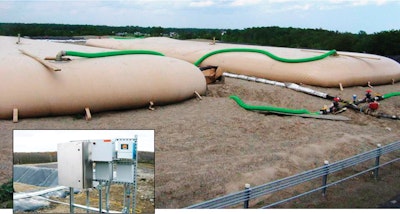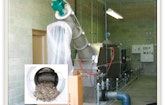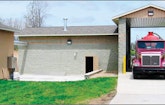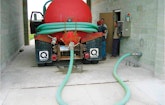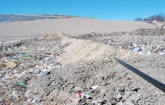Interested in Onsite Systems?
Get Onsite Systems articles, news and videos right in your inbox! Sign up now.
Onsite Systems + Get AlertsA four-year research and development project at the Smiths Creek Landfill in St. Clair County, Mich., has proven that injecting liquid from septage into a bioreactor is economical and environmentally sound. The moisture, nutrients and microorganisms lead to rapid decomposition of the garbage resulting in longer landfill life, increased rate of biogas production, new revenue and another option for pumpers as Michigan phases out land application.
The Smiths Creek story was first featured in Pumper in June 2009. At the time, the bioreactor, located 60 miles north of Detroit, had been operating for a short time and only one pumper was providing septage. Since then, St. Clair County and development partner CTI Associates have patented the technology and formed Alternative Landfill Technologies LLC to market their idea.
“We are working with our state and federal regulators to get the language changed to allow injecting septage liquid,” says Matt Williams, landfill manager. “I don’t think there is any real opposition.”
Pumper: How does the system work?
Williams: Pumpers hook up, swipe an ID card and discharge their load. The septage goes through a rock trap to remove heavy items, then into a Muffin Monster from JWC Environmental to remove trash and homogenize the load. After going through a pH meter, the waste goes to a JWC Honey Monster that screens out solids and separates the liquid. Solids, about 2 percent of the volume, are dumped into bags that get buried in the landfill. The liquid is discharged to two 4,100-gallon lift stations with 7.5-hp Gorman-Rupp pumps, through a 2,500-foot force main into a MPC Containment 50,000-gallon bladder tank.
That is a change from the original design. We now use that for settling of suspended solids to prevent fouling the lines. The liquid is then pumped to another MPC 50,000-gallon bladder tank connected to the bioreactor: a 7-acre landfill cell. The liquid is gravity-fed through perforated lines into 10-foot layers of garbage. The biogas is extracted with 4-inch perforated pipes.
Pumper: How have pumpers reacted?
Williams: Positively. They like that the septage station is clean and neat and they can get in and out quickly. We have four companies delivering on a regular basis. The tipping fee is 5 cents per gallon, the same as the nearest septage receiving station at a wastewater treatment plant 25 miles away in Mount Clemens.
Pumper: What is the timeline for converting to a full-scale project?
Williams: We hope within the next three to five years. We have a total of 12 years for the research project, so we have some time to complete the regulatory changes. When we get the go-ahead, we plan to expand it to the entire landfill, or at least a significant portion.
Pumper: Does septage outperform leachate in aiding decomposition?
Williams: Yes, it does. The decomposition — the biogas generation rate — is about 2 1/2 times greater on the septage side of the bioreactor than on the leachate side.
Pumper: What makes the bioreactor a viable project?
Williams: The increased gas generation rate and enhanced settlement of the refuse. We aren’t getting more gas, we’re just getting it faster, and that makes biogas economical. Refuse settlement (decomposition) is important because it frees up space for more refuse and extends the life of the landfill. We have 25 years left on our current permit and are in the process of extending that another 30 years with some expansion. I’m not sure yet how much longer the life will be with the bioreactor, but it will be significant.
Pumper: When will you start reclaiming biogas?
Williams: Construction started in May and it will be in operation by the end of the year. We provide the gas and get compensated for it. Blue Water Renewables will build and operate the biogas generation facility. They are a subsidiary of Detroit Edison, which has a contract to buy 3.2 mW. Without the bioreactor, we would probably generate around 1.6 mW. The enhanced rate of biogas production allowed Blue Water to install two 1.6 mW Caterpillar 3520 generator sets instead of one. With the bioreactor we’ll get about $600,000 in revenue every year. Without it, we would see substantially less revenue.
We also built the biogas building so we could include the Smiths Creek Environmental Education Center to inform the public about the bioreactor, gas-to-energy, and other county environmental initiatives.
Pumper: Were there some lessons learned?
Williams: Solids management was one. That’s why we now use one of the bladder tanks for settling. The other was winter operations. We have to insulate everything to prevent freezing. We shut down in the winter of 2009-10 because we couldn’t come up with an effective way to prevent freezing. We added concrete curing blankets and tarps over the tanks this past winter and it operated well.
Pumper: How much have you spent and how much more do you expect to spend?
Williams: We’ve spent more than $4 million on research and development, construction, monitoring and analyzing. We don’t really know the cost of expanding, but it won’t be as costly as the research and development.
Pumper: What should landfill operators consider if they’re interested in a similar project?
Williams: Pumpers are the key. You need to be in an area with a lot of septage in about a 25-mile radius. As much as our pumpers like our facility, it comes down to economics for them, too. They’re not going to come here just because they like it.
Pumper: Looking out 25 years, what do you think you’ll see at Smiths Creek Landfill?
Williams: I am hopeful, and pretty confident, that we’ll have a fully commercial bioreactor and will have offered septage disposal to keep it off the fields, out of our streams, and out of our wastewater treatment plants. And that our landfill will have another 40 years of life.
Pumper: This is the first such commercial project and you are half-owner of the technology. What do you see in 25 years for landfill bioreactors?
Williams: That other landfill operators will see it as economically viable. We believe that injecting septage into the landfill is the best way to dispose of it. You can’t do it everywhere, but if you can, it is the best way to handle septage. Our septage bioreactor is a new option for septage disposal, creates a renewable energy source, a new revenue stream, and it extends the life of landfills.
